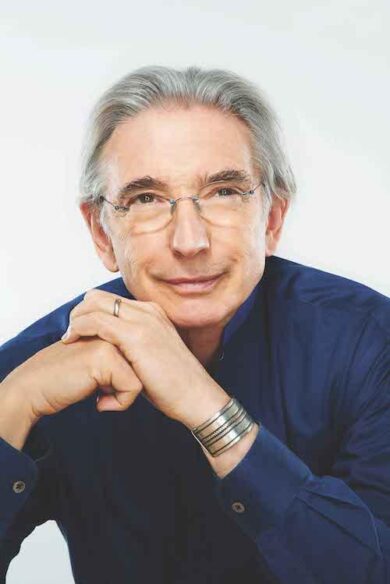MTT leads affecting Shostakovich swan song with NWS, Thibaudet
On Saturday night at the New World Center, Michael Tilson Thomas was greeted by what has become the inevitable standing ovation ever since the news of his diagnosis with brain cancer. Also definitely evident was the extra sense of urgency, concentration, and precision he always draws from the musicians of the New World Symphony. Orchestra and conductor were in peak form, especially in Dmitri Shostakovich’s Symphony No. 15, which concluded the concert.
Completed in 1971, the symphony was Shostakovich’s orchestral swan song. Suffering from repeated heart attacks and injuries from falls, the composer would die four years later. In many ways, the symphony is a portrait, intentional or not, of Shostakovich’s creative life and spirit. Turning from child-like joy and wit to depths of despair and desolation, the score seems to convey the composer’s struggles with the Soviet cultural bureaucracy and its cost to his life and soul.
Tilson Thomas drew out every ounce of color and variety in Shostakovich’s orchestration. The winding phrases of the opening flute solo were assayed with fluent definition by Henrik Heide, a guest New World alum who is now a member of the Cincinnati Symphony Orchestra. Tilson Thomas maintained a fierce, forward-moving pace and illuminated the music’s biting sarcasm. Concertmaster Dominique Bégin brought sterling agility and tonal luminesce to the numerous solos throughout the symphony. The trumpets proclaimed the quotation from Rossini’s William Tell Overture with aplomb.
The score’s mood changed abruptly with the second movement (Adagio). A stern brass chorale heralded a journey into emotional darkness. David Olson’s solo cello, lightly bowed, captured the bleakness of Shostakovich’s discourse. Austin Canon’s lengthy trombone solo rang out in molten tones. Noah Sonderling’s celesta seemed to come from another space, eerie and resolute. Tilson Thomas illuminated the harmonic astringency and sardonic aura of the third movement (Allegretto), the string attacks vigorous and brass crackling.
In many ways, the concluding Adagio-Allegretto is the symphony’s heart, representing Shostakovich at his most Mahlerian. (Prokofiev once referred to him as “our little Mahler.”). The fate motif from Wagner’s Der Ring des Nibelungen resounded sonorously in the horns and brass. From the softest pianissimos to full-throttle percussion and ensemble climaxes, Tilson Thomas drew a wide range of nuanced and transparent dynamics from the ensemble. The concluding quiet reprise of the score’s opening theme and soft strokes from the percussion seemed almost like a death knell. The audience remained admirably quiet and still at the final chords. When Tilson Thomas nodded, a long standing ovation ensued, with the conductor acknowledging multiple individual players.
The program’s first half was no less rewarding. Tilson Thomas has always displayed the ability to make even the most familiar works sound freshly minted. He did exactly that with a thrilling rendition of Tchaikovsky’s Romeo and Juliet. The initial wind lines depicting Friar Lawrence, taken at a stately tempo, were given strong emphasis. The battle music of the warring families emerged vigorous and incisive, the brass climaxes registering real impact. A spacious traversal of the love theme highlighted inner voices with absolute clarity, and the string sound was lustrous. There was extra thrust in the climactic pages, capping a reading that demonstrated anew the power and beauty of Tchaikovsky’s opus.
Jean-Yves Thibaudet was the soloist in Ravel’s Piano Concerto in G Major. A fashion plate in black leather and blue shoes, Thibaudet is a master of this repertoire, and his performance astutely mixed virtuosic dexterity with lightness and charm. Vibrant solos by Allison DeFrancesco on piccolo and Alan Tolbert on trumpet set the frothy Allegramente in motion. Thibaudet’s speed and immaculate technique astutely captured both the bluesy aura and Gallic perfume of Ravel’s final major score. Alternately percussive one moment and delicately caressing the keys the next, his pianism was wonderfully idiomatic and seasoned with spontaneity and keen musicianship. He conjured up the reverie of the Adagio with Mozartean elegance. Tilson Thomas beautifully melded the winds with the keyboard, the blend well nigh perfect. Setting a taut pace, Thibaudet assayed torrents of notes in the finale with the final crescendo dazzling.
Bravos immediately rang out at the concerto’s conclusion. After several curtain calls, a second piano bench was brought on stage and Thibaudet and Tilson Thomas played Poulenc’s Sonata for Four Hands as an encore. The conductor proved just as fleet-fingered as his French colleague. Jazzy syncopations were brisk and cleanly articulated while a lovely, poetic touch emblazoned the lyricism of the central episode. Clearly Tilson Thomas and Thibaudet were enjoying themselves just as much as the audience.
The program will be repeated 2 p.m. Sunday at the New World Center in Miami Beach. nws.edu
Posted in Uncategorized
One Response to “MTT leads affecting Shostakovich swan song with NWS, Thibaudet”
Leave a Comment
Sun May 5, 2024
at 1:56 pm
1 Comment

Posted May 05, 2024 at 4:14 pm by Cathy M
A wonderful concert, happy to hear MTT and the fellows at the near end of the season. A fitting end piece to what may be the finale to MTT at the NWS. Hope not.